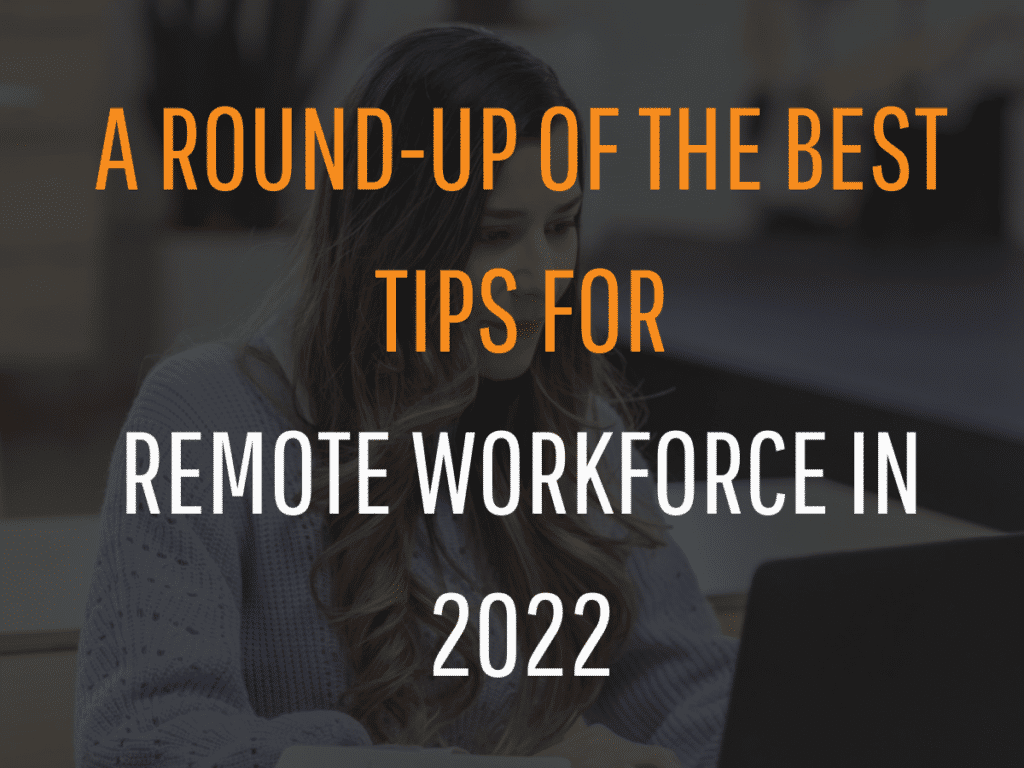Here’s our best advice for navigating the new normal in the coming year.

Post-pandemic, one thing is crystal-clear: We’re not going back to the old normal. Over the past year, companies have been honing their ability to manage a remote workforce. We’ve all made blunders (and had plenty of Oh Ship! moments), but as we dug deep into our creative capabilities, we’ve come up with some ingenious solutions as well. Now, it’s time to compare notes and learn from each other’s successes. Let’s take a look at the best ideas from 2021 that can inform how we work in 2022.
Build in organizational resilience.
Organizational resilience allows you to dynamically adapt to unpredictable changes. Having emotional intelligence, a strong social network, and a proactive approach to assessing risk will prepare you for innovative problem-solving.
Further, having employees with overlapping skills will guard against disruption. “Whereas built-in redundancy or overlaps in skills might previously have been seen as inefficient, today, it’s seen as a sensible precaution,” writes Forbes.
How to build in those skills? Cross-training employees and providing job-shadowing opportunities will help them prepare to handle other roles if the need arises. Refresh your leaders’ skills so they can infuse more energy into their teams. Most importantly, impart leadership skills to employees throughout your company so they can step up to the plate if needed—regardless of their current position. And give them the chance to put these skills into practice so they’ll feel more confident when the moment arises.
Build (or enhance) your digital identity.
Rebrand yourself as a digital leader (or strengthen that brand). Having a great digital brand will attract not only customers but also potential new hires.
- Re-map the customer journey. If you’re not already marketing direct to the consumer (DTC), now might be the moment to begin. How can you reach them through new channels that cut out the middleman? Choose social platforms that your target audience uses.
- Leverage tactics like creating microcontent, infographics, and alliances with influencers to reach potential customers wherever they are. Focus on building your audience rather than making sales. Roll out an engaging ecommerce store with shareable content, speedy customer service, and reviews from real customers.
Reevaluate organizational roles. As responsibilities change, some roles may need to be redesigned or added (e.g., Chief Digital Officer, Head of Ecommerce, User Experience Designer). Conduct a thorough audit of the tasks your employees fulfill and recraft descriptions and titles to match your findings.
Taking these steps will help you supercharge your digital brand—or even become a digital influencer. That being said…
Take action to curb digital overload.

Productivity has soared since 2020, but that alone doesn’t signal that employees are thriving. In fact, burnout has probably contributed to the great resignation of 2021. In particular, remote employees are likely to suffer from digital burnout.
Among Microsoft Teams users, the average meeting goes for ten more minutes than it did a couple of years ago. Employees are sending 45% more chat messages—and 42% more messages after work hours. And 62% of calls and meetings are unscheduled, says Microsoft. While some of this increased digital communication is inevitable, we still need to dial it back to avoid digital burnout. We can achieve this through actions like these:
- Cut out “admire the problem” sessions where everyone discusses an issue but leaves it unresolved. Instead, send everyone the necessary background info prior to the meeting so you can launch right into solutions.
- Set strict time limits for your meetings (e.g., 30 minutes), putting only the most critical topics on the agenda.
- Create a culture of “calling out” after-hours communications. If someone sends you an email at 11 p.m., check in with them the following morning to find out if they’re feeling overloaded!
Consider a flatter, more agile structure.
Increasingly, organizations are adopting more horizontal structures, which allows work to happen more fluidly. Agile teams converge around specific projects and disperse after they’re completed. A flatter structure can also empower everyone to act like a leader and feel more deeply invested in the projects the team pursues.
As a remote organization, you may already be using a nontraditional model such as a hub-and-spoke approach. If not, consider whether such a model may serve your needs—and whether teams have the agility to operate as efficiently as possible. Empowering teams with the resources and authority to make decisions in real-time whenever possible will eliminate bureaucracy, helping them accomplish more together.
Create a human-centric employee experience.
Smart employers are realizing they need to redesign the employee experience based on what their team wants and needs. Here are a few key ways to provide a top-tier experience for them:
- Make a great impression on new hires by ensuring recruiters understand the benefits package inside and out. Offer mental health days and quality mental health care along with a range of other wellness perks.
- Find ways to have fun. The team may already have a sense of camaraderie, but it’s vital to sustain it, especially as you bring on new employees. Send out a silly poll and announce the results at a meeting; play a game virtually on occasion. Helping everyone to loosen up will spark informal conversations and a greater sense of belonging.
- Show empathy for everyone you interact with, all day and every day. By simply checking in about how they’re doing, making everyone feel included in projects or meetings, and providing guidance when they’re struggling, you’ll show compassion for them.
Provide facetime with leaders.
In a physical office space, employees have the chance to bump into leaders they don’t work with directly and develop a rapport. In a remote workforce, engagement between leaders and employees needs to be designed in, or it may not happen. Leaders will benefit from knowing who they can call on to solve particular challenges, and employees’ opportunities for success will expand.
How to create such opportunities? Here are a few ideas:
- Have leaders hold periodic focus groups with small groups of employees to gain their thoughts on an issue.
- Pair up leaders with teams they don’t normally work with for a virtual lunch each month.
- Encourage managers to bring a talented employee to a higher-level meeting to share expertise on a specific agenda item.
Boosting engagement between leaders and employees will also help ideas to circulate freely through all levels of your organizational structure. Remember that great ideas can arise from any of your talented people!
We’ve seen companies experiencing outstanding results from implementing these ideas. Each of them has the potential to greatly enhance job fulfillment among all members of your team. As you redesign your structure, combat overwhelm, rethink the customer journey, and enhance your resiliency, you may end up with a stronger and more tightly knit team than ever.





